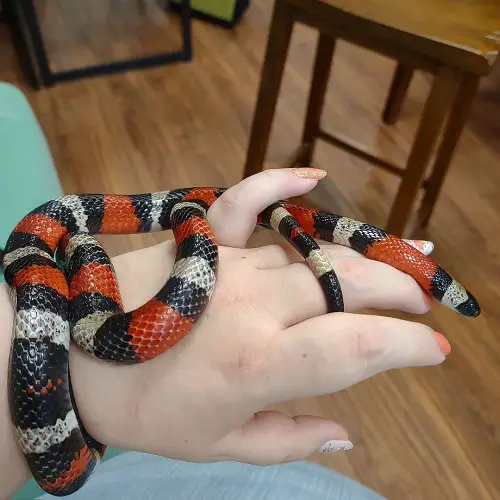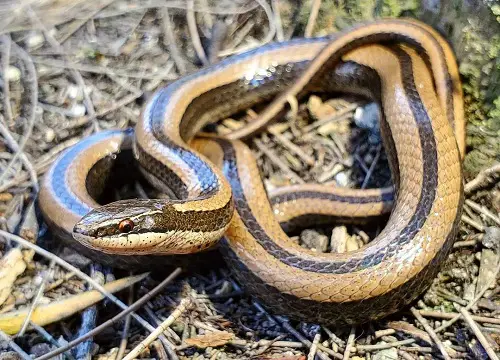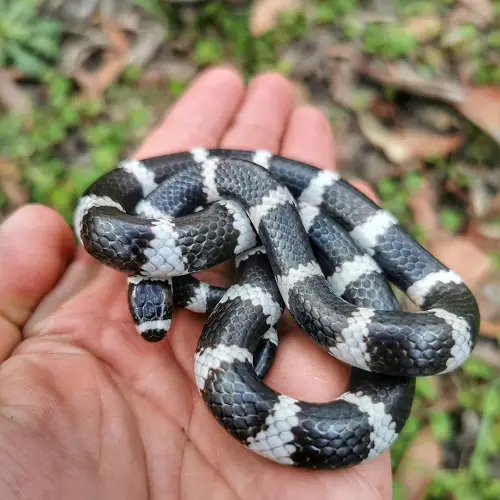Black Snakes with White Stripes have an exceptional color combination that’s simply hard to ignore! Here are the best ones!
Discover the fascinating world of Black Snakes with White Stripes – creatures that combine striking aesthetics with vital ecological roles. Whether you’re an avid herpetologist, a nature enthusiast, or simply curious about these unique reptiles, you won’t want to miss what’s coming next. Read on to uncover the enigma surrounding these beautifully striped reptiles and learn why they deserve your attention.
Black Snakes with White Stripes
Some of the snakes on this list may not exhibit pure white stripes and have a cream coloration.
1. California Kingsnake

Scientific Name: Lampropeltis californiae
Native Habitat: Western United States
Toxicity: Non-venomous
These Black Snakes with White Stripes boast glossy black bodies with bold, white stripes running along their backs. They are constrictors, typically feeding on rodents and other small reptiles.
2. Milk Snake

Scientific Name: Lampropeltis triangulum
Native Habitat: North and Central America
Toxicity: Non-venomous
Milk Snakes feature black bodies adorned with white and red bands/lines, often resembling the pattern of venomous Coral Snakes. They are docile and are frequently found in a variety of terrestrial habitats
3. Black Striped Snake

Scientific Name: Coniophanes imperialis
Native Habitat: Central and South America
Toxicity: Non-venomous
These Black Snakes with White Stripes have a slender body with lines on a cream background. They are non-venomous and feed on insects, small vertebrates, and eggs.
Check out Birds with Red Chest here
4. Striped Whipsnake

Scientific Name: Masticophis taeniatus
Native Habitat: Southwestern United States and northern Mexico
Toxicity: Non-venomous
The Striped Whipsnake, with its slender body and distinctive dark stripes, inhabits arid and semi-arid habitats, including deserts, grasslands, and scrublands. It primarily feeds on a diet of lizards, small rodents, and birds.
5. Eastern Kingsnake

Scientific Name: Lampropeltis getula
Native Habitat: Eastern United States.
Toxicity: Non-venomous.
Kingsnake stands out by its distinctive appearance, featuring a glossy black body adorned with white or yellow bands. These adaptable snakes are found in woodlands, grasslands, and swamps. They primarily feed on rodents, birds, and other small reptiles.
6. Long-Nosed Snake

Scientific Name: Rhinocheilus lecontei
Native Habitat: Southwestern United States and northern Mexico.
Toxicity: Non-venomous.
These Black Snakes with White Stripes are popular for their slender body with a dark background color and a series of white or yellow longitudinal stripes or bands. Their diet consists of small mammals, lizards, and occasionally other snakes.
7. Western Terrestrial Garter Snake

Scientific Name: Thamnophis elegans
Native Habitat: Western North America, including regions of the United States and Canada.
Toxicity: Non-venomous.
These garter snakes have slender body and feature a background color ranging from green to brown or gray/black. These Black Snakes with White Stripes primarily feed on amphibians, small fish, and invertebrates.
8. Puget Sound Gartersnake

Scientific Name: Thamnophis sirtalis pickeringii
Native Habitat: Pacific Northwest region of North America.
Toxicity: Non-venomous.
These snakes have a distinctive dark coloration with three white stripes running down their back. Puget Sound Gartersnakes primarily feed on amphibians, small fish, and invertebrates.
Fish Head Benefits for Plants | How to Use Fish Head in the Garden
9. Bandy Bandy Snake

Scientific Name: Vermicella annulata
Native Habitat: Parts of Australia
Toxicity: Non-venomous.
The Bandy-Bandy Snake is characterized by its striking appearance with a black body and distinctive white rings or bands encircling it. These snakes are known for their specialized diet of snake eggs and smaller snakes.


